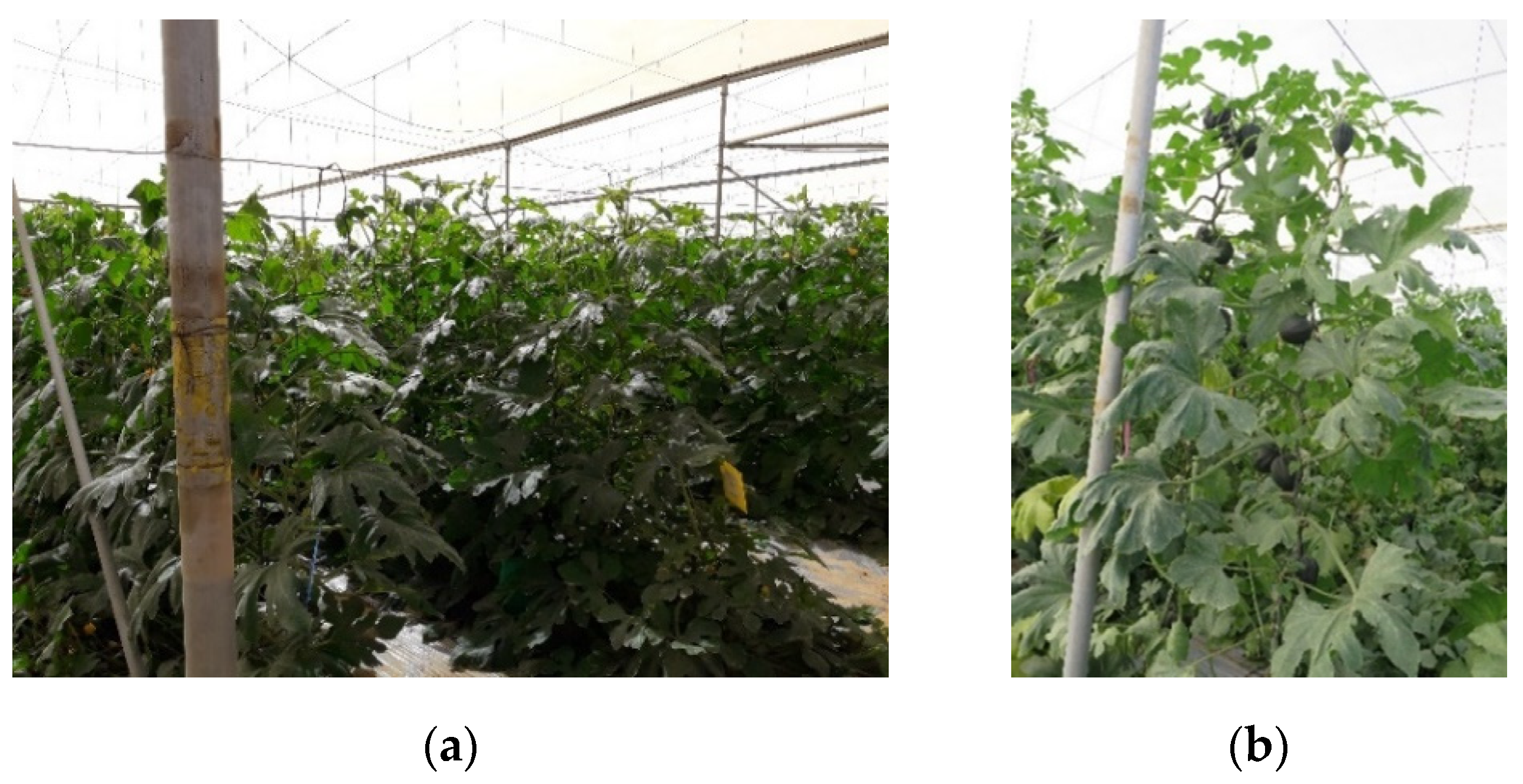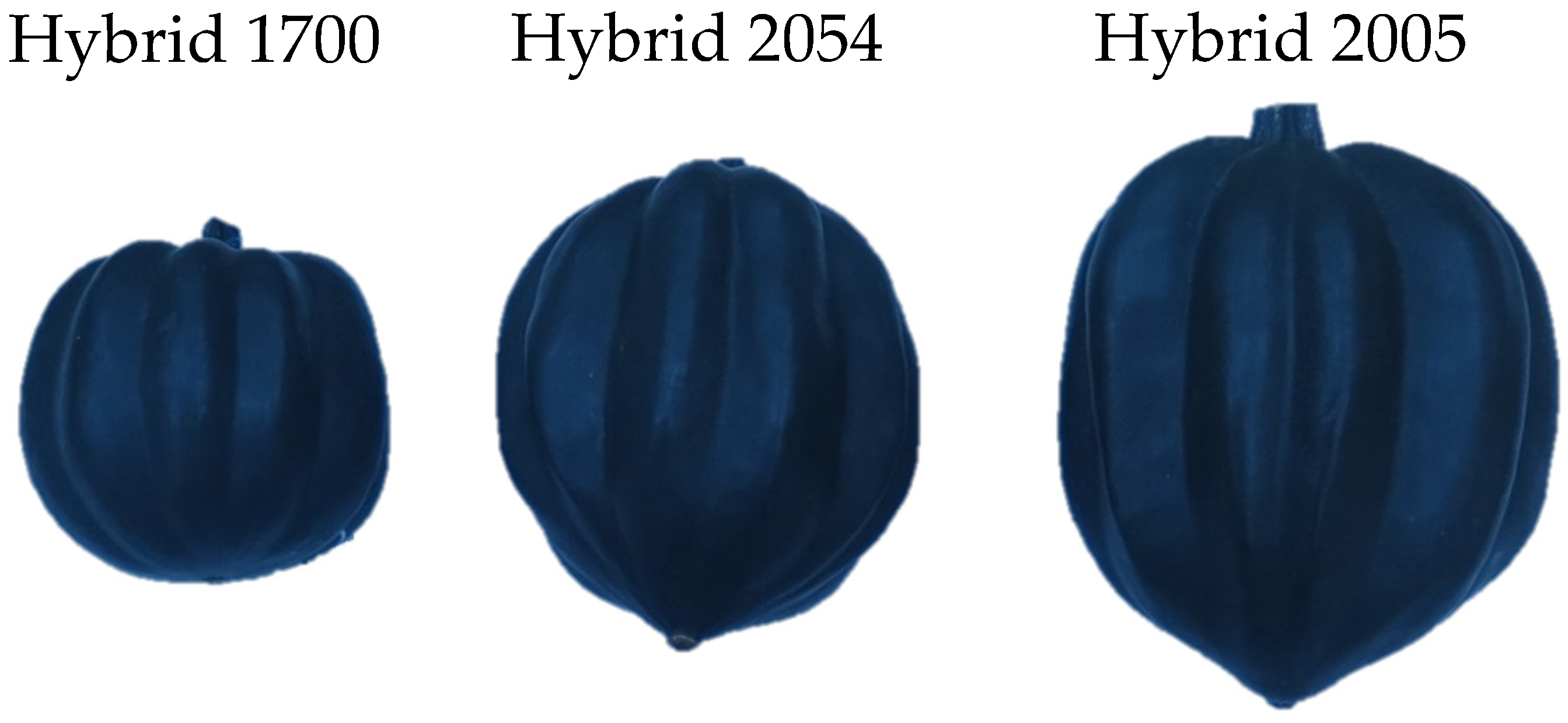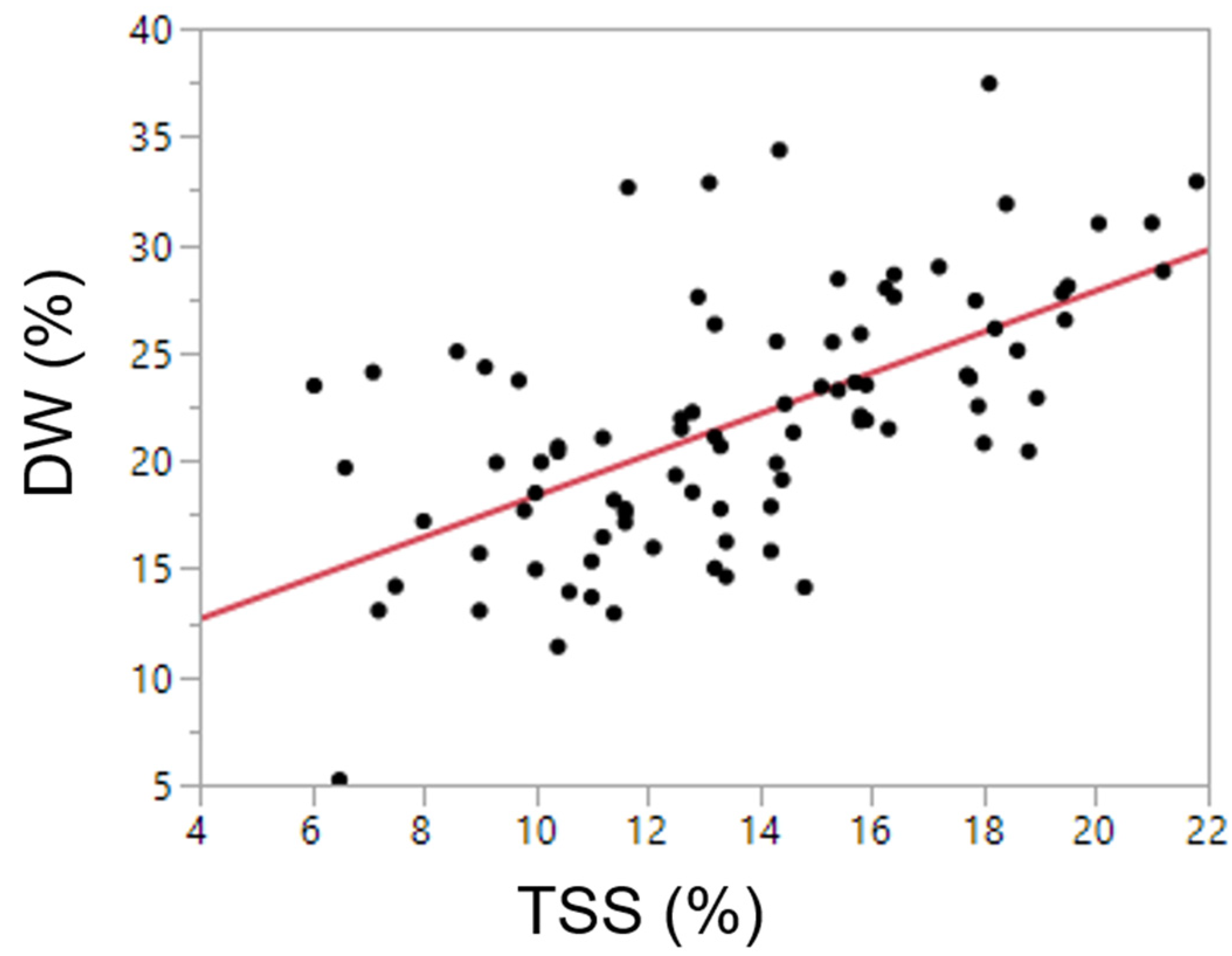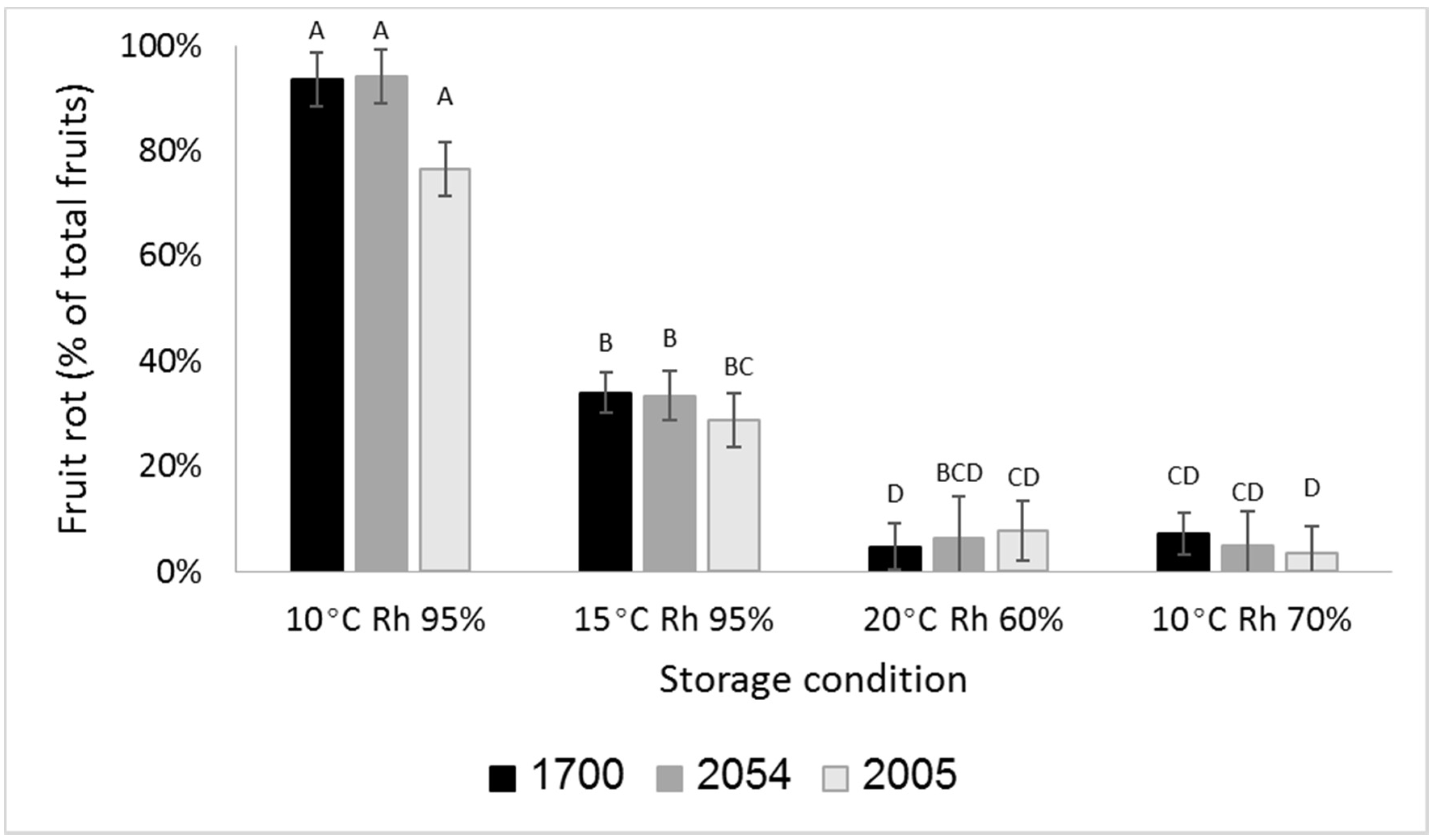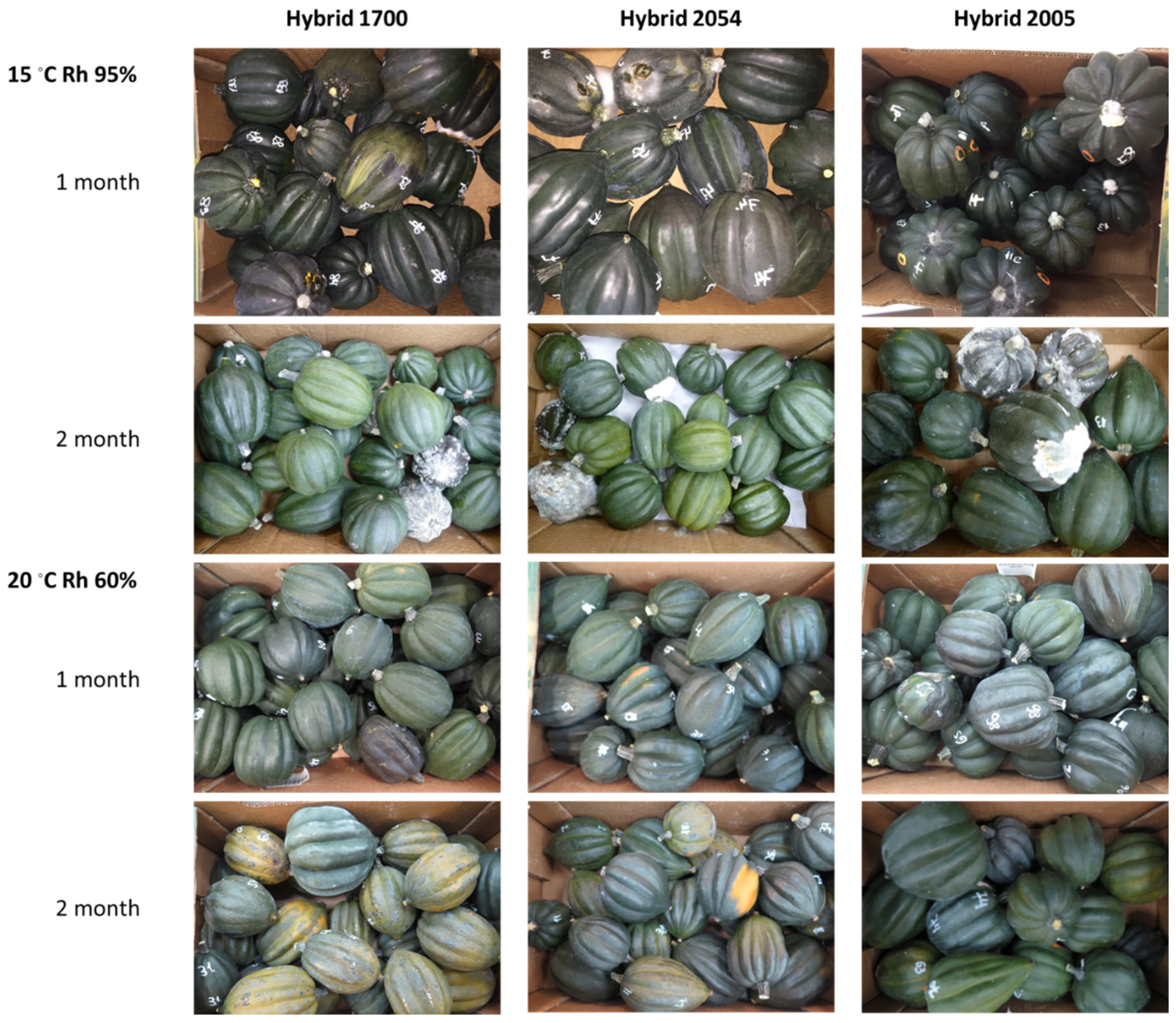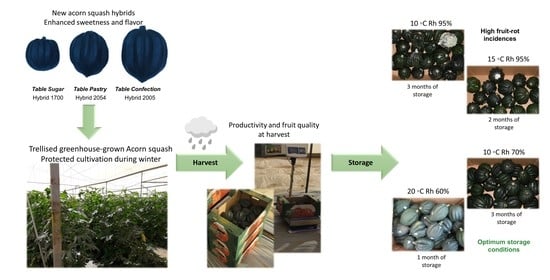1. Introduction
Acorn squash,
Cucurbita pepo subsp.
texana Acorn Group, is a familiar produce item in the United States and Canada. Acorn squash were developed by Native North Americans in pre-Columbian times [
1,
2]. Mature acorn squash are rather small, usually ranging from 250 to 1000 g in weight and are turbinate, with distinct alternating ridges and furrows [
3]. The external color of acorn squash cultivars varies widely, in shades of green, yellow, and orange, from nearly black to nearly white, and can be longitudinally striped and or latitudinally bicolor. Most commonly, though, they are dark green. When well grown and allowed to ripen fully, acorn squash have a pleasing flavor and a soluble solids content of 8–11% [
4,
5].
Fruits of acorn squash reach their maximum size at approximately 20 days past anthesis (dpa) [
4,
5]. Accumulation of dry matter, mostly starch, in the mesocarp (fruit flesh) occurs in parallel with increase in fruit size and then continues for approximately 20 more days, until 35–40 dpa. By 40 dpa, dry matter content of the mesocarp begins to decrease, coinciding with late stages of embryo development and seed fill. As seed fill is occurring, starch is converted to sugars. Dry matter content in acorn squash fruit flesh usually reaches a maximum between 12 to 20%. This modest dry matter content is not high enough to assure good eating quality and consistency of the cooked squash.
During storage of acorn squash, sugar content of the mesocarp tends to increase and high sugar levels are much preferred by consumers, but starch content decreases, resulting in a thinner, looser, more fibrous consistency of the fruit flesh [
5]. Moreover, large commercial growers tend to harvest acorn squash at approximately 30 dpa or even earlier, long before they have achieved maximum sweetness. Squash harvested at this stage will have approximately 7% total soluble solids content, too low to have acceptable palatability, but if stored for three weeks, can reach an acceptable level of 10%. However, if the dry matter content of the squash at harvest is only around 15%, then its conversion to sugar in storage will result in the fruit flesh having an unacceptable thin, loose, fibrous consistency upon cooking.
Over the past few decades at the Agricultural Research Organization in Israel, efforts were devoted to developing a much improved acorn squash [
6,
7]. The efforts focused on introgressing four characteristics: (1) Black-green fruit color replaced dark green, for a more attractive appearance; this replacement proved to be more important than realized at first, by increasing the longevity after harvest of the green hue and by its seeming association with a distinct, roasted chestnut flavor imparted to the fruit flesh. (2) Bushy growth habit replaced viney growth habit. (3) Plant resistance to powdery mildew was introgressed from a straightneck squash. (4) Increased sweetness of the fruit flesh was introgressed from germplasm developed by J.R. Baggett at Oregon State University. These efforts resulted in the release of Acorn Hybrid 1700, named ‘Table Sugar’, in 2007. The plants of this new cultivar are bushy and resistant to powdery mildew, and its fruits are small, averaging 350 g, with a black-green exterior and fruit-flesh soluble solids content ranging from 12–18%. A decade later, the larger fruited Acorn Hybrid 2005, named ‘Table Confection’, and Acorn Hybrid 2054, named ‘Table Pastry’, were released.
Since its release in 2007, ‘Table Sugar’ has been produced mostly in the open field, in late winter to late spring plantings [
6]. The fruits were harvested and offered for sale from May until July. As consumers became familiar with this premium product, demand grew for a continuous year-round supply. However, summer and fall plantings were not practical due to high virus pressure vectored by whiteflies,
Bemisia tabaci, and winters too cool for production in the open field. Covered (protected) cultivation is highly effective in preventing virus infection, a major threat to cucurbits all over the world [
8] and the possibility of growing ‘Table Sugar’ acorn squash in netted greenhouses during the winter has been explored. An experimental trellised growth of acorn squash in protected greenhouses covered with 50 mesh insect-proof nets has enabled a long growth period for planting in the late summer or fall (August and September) and harvesting in the winter, thereby providing both, heat and protection against viruses (Avraham and Ziv, unpublished).
In late winter and early spring, there is a market shortage of ‘Table Sugar’ and the prices are very high, reaching approximately US
$12.50 per kg. Late summer- and fall-planted acorn squash, which bear in winter, would require storage in order to enable their marketing during the peak period of prices in the spring. In order to ensure stable and profitable marketing of acorn squash during this period, an adequate management of postharvest diseases is required. Previous work evaluated postharvest treatments and storage conditions of summer, field-grown ‘Table Sugar’ acorn squash and determined that storage at 15 °C after hot water rinsing and brushing can enable long-term storage of these fruits with only mild effects of fruit quality [
9]. However, the trellised, protected cultivation in the fall and winter has called for a complete re-evaluation of this storage protocol. The current work is the first to systematically evaluate and compare the productivity, fruit quality and storability of trellised greenhouse-grown, winter-produced, sweet acorn squash and presents an optimal protocol for their storage.
2. Materials and Methods
2.1. Plant Materials
Experiments were conducted with acorn squash fruits of ‘Table Sugar’ (Hybrid 1700), ‘Table Confection’ (Hybrid 2005), and ‘Table Pastry’ (Hybrid 2054). Seeds were obtained from Origene Seeds (Giv‘at Brenner, Israel).
2.2. Growing Conditions
Acorn squash plants, approximately 17 days after seeding in trays in a commercial facility, were transplanted into a netted greenhouse covered with 50 mesh insect-proof netting at the Besor Experiment Station in southwestern Israel (31°16′20″ N, 34°23′15″ E). The transplants were laid into the sandy soil 40 cm apart in a single row, with 2 m spacing between rows. This resulted in a population density of 1250 plants per 1000 square meters. Each cultivar was planted in four plots of a randomized complete block, each plot being 10 m long and containing 25 plants, for a total 100 plants per cultivar. During the growing period, the plants were supported for vertical growth using Dutch trellising (
Figure 1).
The experiments were performed in three consecutive years beginning in 2017 (
Table 1). For the first two years, two-and-a-half week-old seedlings were transplanted during September. The third experiment was transplanted in August. During all seasons, pollination was performed by bumblebees (genus
Bombus), and three harvests of fruits were performed after 2–5 months of growth (
Table 1).
2.3. Experiments and Treatments
2.3.1. Harvesting
Over the course of each of the three years of the experiment, fruits of all three cultivars together set, developed, and ripened in three cycles. Therefore, three harvests were performed for each experiment. Fruits from the same fruit-set cycle were therefore fit for comparison and were harvested from the three cultivars simultaneously. The timing of the harvest was determined by fruit size (when reaching full size) followed by cutting open 8–10 randomly selected fruits from the entire greenhouse to assess the maturity of the seeds and the color of the fruit flesh. Evaluations of fruit quality were performed for all harvests of 2017, the first and the second harvests of 2018, and the second and third harvests of 2019 (
Table S1). On the day of harvest, fruit weight and rind color were assessed for all fruits. Flesh color, fruit firmness, TSS, and dry weight were assessed for 6–8 fruits of each cultivar.
2.3.2. Postharvest Handling
After harvest, the fruits were washed by tap water rinsing and brushing (TWRB) or hot water rinsing and brushing (HWRB, see below) in a designed sprinkler system, air-dried, and stored in boxes. After washing, each fruit was numbered and weighed before storage. Overall, 600 fruits were evaluated in the first year, 700 fruits were evaluated in the second year and 400 fruits were evaluated in the third year of the experiment.
2.3.3. Hot Water Rinsing and Brushing Treatment
Fruits treated with HWRB (54 ± 1 °C for 15 s) were air-dried and then stored at 15 °C [
9]. The treatment was applied to 30 fruits of each cultivar from the three harvests, during the first year of the experiment (90 fruits for each cultivar). The treatment was not evaluated during the next years of the experiment due to its inefficacy in preventing fruit deterioration during storage.
2.3.4. Storage Conditions
The treated fruits as well as control untreated fruits were stored at 15 °C and 95% Rh, as recommended by Chalupowicz et al. [
9]. During the second and third year, untreated fruits were stored in an additional three conditions (
Table 2), with at least 20 fruits of each cultivar per harvest stored in each condition. The temperature and relative humidity during storage were constantly monitored by a data logger (EL-USB-2, Lascar Electronics, Whiteparish, UK). To obtain the low-humidity atmosphere at 10 °C for the “10 deg Rh 70%”, a drier controlled by a humidity sensor was placed in the storage room.
The stored fruits were routinely evaluated for rots during the storage period. Rotting fruits were documented and discarded to prevent contamination of neighboring fruits. The cumulative data of the infected/rotting fruits is reported.
2.4. Fruit Quality Evaluation
Several parameters indicative of fruit quality were measured at the beginning and at the end of the storage period:
Weight loss Fruits were weighed on the day of harvest (prior to storage,
W0) and at the end of the cold storage period (final weight,
Wx). In addition, fruit weight was measured at different time points during the storage period. Statistical analysis was performed for each storage period, separately. Weight loss was calculated using this formula (1):
Rind Color: Fruit epidermal color before storage (t = 0) and at the end of storage was evaluated quantitatively for all fruits using a Chromometer CR-400/410 (Konica Minolta, Osaka, Japan). Two measurements at the blossom (stylar) end area of each fruit were taken, and the results are expressed as Hue angle (Hue°).
Total soluble solids (TSS): Samples of fruit flesh were frozen overnight and thawed. The fruit flesh samples were squeezed and their juice thereby extracted onto a Palette Digital Refractometer PR-1 (Model DBX-55, Atago, Tokyo, Japan), with 6–8 fruits per treatment before and after storage. The results are expressed at percent TSS.
Dry weight (DW): The fruits were peeled and the fruit flesh cut into pieces 3–5 mm wide. The exact weight of an approximately 10 g piece of the fresh tissue (
WF) was recorded and the piece placed on an aluminum plate. The sample was dried in an oven at 55 °C for 3 days. The weight of the dried sample was taken (
WD). The DW was determined by using the following formula (2):
Flesh color: Fruit-flesh color was quantified before storage and at the end of the storage period for 6–8 fruits per treatment/repeat using a Chromometer CR-400/410 (Konica Minolta, Osaka, Japan). Fruits were cut equatorially at the approximate middle of the length of the fruit and measurements of flesh color were taken from three approximately equidistant points. The results were calculated as color space value a *, that was shown to be correlated to total carotenoid content in pumpkins and squash [
10].
External firmness: Fruit firmness was determined for 6–8 fruits per treatment/repeat before storage and at the end of the storage period. Measurements were performed using a motorized Chatillon penetrometer equipped with a 6-mm conic plunger (John Chatillon & Sons, Kew Gardens, NY, USA); Firmness was determined at two points for each fruit; each measurement was applied on opposite sides of the fruits, at the equatorial region, and the data were recorded in Newtons (N). Since this is a destructive measurement, these fruits were then used for determining pulp color and for extracting the juice for TSS assay (as described above).
Decay: Fruits were visually inspected for signs of mold (hyphae or conidia). Fruits were considered to be decayed as soon as rot became visible. Decay is reported as percent infected fruits.
Taste: Taste was evaluated using hedonic analysis to check sweetness, bitterness, texture, and overall acceptance by 28–30 untrained people. The fruit flesh (pieces of 5 g, without peel and seeds) were cooked for 4 min under full power in a microwave oven. Cooked pieces of four fruits per treatment were mixed in one plate. Each tasting experiment included six treatments (three cultivars at two storage conditions). Each taste test was performed twice, for fruits from two different harvests.
2.5. Carotenoid Identification and Quantification
Carotenoid extraction was performed using established protocols [
11,
12,
13]. In short, 0.5 g fresh tissue was ground under liquid nitrogen. Carotenoids were extracted and analyzed by HPLC to identify the carotenoids in the fruit flesh of 10 fruits of the three acorn squash cultivars. The absorbance of the extract was measured at 455 nm for determining β-carotene content.
2.6. Statistical Analysis
Three postharvest experiments during the first year and two postharvest experiments during the second and third years were conducted. In each experiment, each treatment consisted of 2 cartons, with 10–15 fruits per carton (20–30 fruits per treatment), for two repetitions per treatment. All data were subjected to Tukey-Kramer tests by one- or two-tailed ANOVA from 0.05 to 0.0001, with the JMP-14 Statistical Analysis Software Program (JMP® Pro 14.1, SAS Institute Inc, Cary, NC, USA). Significance was set at p ≤ 0.05.
4. Discussion
Acorn squash are a nutritious fruit vegetable appreciated for their attractive appearance, convenient size, culinary versatility, and long storage life [
3,
6]. Acorn squash are a good source of vitamin C, potassium, magnesium and folic acid [
14,
15,
16]. Their yellow-orange flesh is also an excellent source of carotenoids, mostly beta-carotene and lutein [
17,
18].
The acorn squash grown in Israel are almost exclusively of the new black-green-fruited, ultrasweet ‘Table Sugar’ (Hybrid 1700), ‘Table Confection’ (Hybrid 2005), and ‘Table Pastry’ (Hybrid 2054), developed by the Agricultural Research Organization [
7]. ‘Table Sugar’, which was introduced in 2007, became popular after concerted efforts by a licensed vendor, Origene Seeds, to connect among growers, wholesalers, retailers, chefs, and consumers, the whole marketing chain, for introducing what was for Israel an entirely new product. Since its introduction, the area and production of ‘Table Sugar’ has expanded constantly in Israel. It is recognized by consumers as a premium product and they expect supreme quality for the high price they pay for it, which is more than double that of other pumpkins and winter squash. To legally safeguard this new product against cheaper, inferior imitations, invariably imported, the vendor trademarked the local Hebrew name for this product,
Dela‘at ‘Armonim.
The yields of ‘Table Sugar’ were low, and this is the major reason for the high price of its fruits on the market. Winter squash and pumpkins having high dry matter content produce lower yields, by fresh weight, than those low in dry matter and hence of lower quality [
5]. Hybrid 2005 and Hybrid 2054, which were released in 2017, were bred to bear larger fruits, leading to higher yields for farmers, without sacrificing much in dry matter content and quality. The results presented in
Table 3 show that these newer cultivars have higher yields and larger fruits than ‘Table Sugar’, but produce the same number of fruits. At harvest, dry matter content of the fruit flesh was very high for all three hybrids, 22.6% for ‘Table Sugar’, even higher 24.6% for Hybrid 2054, and 19.7%, for the largest-fruited Hybrid 2005 (
Table S1). On the day of harvest, total soluble solids were quite high too, with ‘Table Sugar’ and Hybrid 2054 averaging over 15% and Hybrid 2005 13.5% (
Table S1). During the first two years, the fruits of the first harvest were 60 days or more past anthesis (dpa) (
Table 1). Even at this late stage of development, the fruits of the three hybrids averaged over 20% dry weight. Having both, high dry matter content and high TSS simultaneously in the fruit flesh may be unique to these three cultivars. Fruits of most acorn squash cultivars attain 15% dry matter at their peak, 25–30 dpa, at which time they have 7% TSS [
5,
19]. Improved, sweet acorn squash in the U.S.A. have reached peak dry matter of 20–21% at 25 dpa, at which time they also average 6–7% TSS [
4]. At 45 dpa, fruits of these same improved cultivars achieve 13% TSS at harvest and 14% TSS after 10 days storage at 21 °C [
19]. The widely different growing conditions between Israel and the U.S.A. make comparisons difficult, as it is unknown if the causes for the differences in dry matter and TSS are mostly genetically or environmentally determined. However, ‘Table Sugar’ has given similar results for TSS in the present experiments (
Table S1) and in field-grown, spring-summer crops in Israel [
7]. In this light, it would be worthwhile to check and compare dry matter content as well as total soluble solids at closer intervals over the course of fruit development under various growing conditions in different seasons.
The newer cultivars, especially Hybrid 2005, showed superior traits over ‘Table Sugar’ by having significantly higher yields (
Table 3), blacker rind color (
Table S1), and less weight loss during cold storage (
Table 5). Although Hybrid 2005 performed better in storage, maintaining its black-green rind color and being less prone to fungal rots, its TSS and hedonistic impression were lower than those of the other two cultivars (
Figure 10 and
Figure S4). Although higher yields of a cultivar are an obvious advantage to the farmer, consumers demand the best tasting fruits and in Israel, it seems, also prefer fruits that are not so large.
During fruit development and ripening, sugars, starch and carotenoids accumulate and significantly affect fruit sweetness, texture and nutritional values, respectively [
20,
21,
22]. Fruit acidity in pumpkin and squash is low (0.04–0.3% of FW, pH 6.8) and has no effect on the fruit sensory quality [
23,
24]. Our data indicate that when well-grown and properly stored, the fruits of the three new acorn squash cultivars can accumulate on average as much as 20% TSS at harvest and in storage (
Table 4,
Table 5, and
Table S1), and thus are a very sweet vegetable indeed. Longer storage periods may result in bitterness that affects acceptance. Interestingly, our unpublished data indicate that during cooking, fruit TSS is further increased, probably due to starch degradation during the processing and either steaming or microwave cooking.
During ripening and postharvest storage, the fruit flesh intensifies in color as carotenoids accumulate [
12]. Here we observed that the major carotenoid of ripe acorn squash fruits was β-carotene (accumulating up to 23 µg/g FW), while lutein content was low (
Figure S3). These results are consistent with previously described carotenoid levels of acorn squash [
21] and of other squash having orange flesh [
11]. Two other carotenoid peaks were detected which might be xanthophylls, but further research is required to identify them.
In order to promote the growth of acorn squash in Israel during winter, we have evaluated trellis cultivation in a netted greenhouse, which enabled three harvests per season with a 50% increase in yield (Avraham and Ziv, unpublished). However, these growing conditions resulted in a significant increase in decay incidence of the fruits during storage. While chemical pesticides can provide effective control of fungal rots during storage, the potential risk to humans and environment posed by chemical control and the growing awareness of the customers to fruit quality and safety urged us to seek non-hazardous means to control postharvest rots of fruits caused by phytopathogenic molds. For this purpose, we previously examined the potential of precise steam treatments to prevent fruit rot of acorn squash and reduce fruit losses during long-term cold storage, which was found to be effective but had a negative effect on fruit appearance [
25]. In addition, it was shown that hot water rinsing and brushing (HWRB) can significantly reduce the decay rate of summer, field-grown acorn squash fruits when stored for 3.5 months at 15 °C [
9]. However, HWRB was less effective in preventing fruit decay when the fruits were grown in a greenhouse for harvest during the winter (
Figure 6). This may be due to a significantly higher inoculum load of fungal spores already attached to the fruits in the greenhouse. Thus, under these growing conditions, more effective means of controlling fruit rots during storage are required.
The optimum storage temperature for squash is 10–15 °C. Storage temperatures lower than 10 °C may cause chilling injury, depending upon the degree of field acclimation to cold temperatures experienced by the squash [
26]. Previously, from spring-summer field-grown ‘Table Sugar’, 15 °C appeared to be the best storage temperature to keep the fruits for 3.5 months [
9]. At 10 °C, although fruits lost less weight and were much greener, decay incidence was significantly higher. Our results clearly indicate similar effects of storage temperature for all three cultivars tested, although fruits of Hybrid 2005 were slightly more adapted to 10 °C storage conditions (
Figure 6). Interestingly, lowering the humidity at 10 °C significantly reduced decay incidence, indicating humidity is a critical factor affecting acorn-squash susceptibility to fungal infection. Maintaining low humidity is a common practice of grain storage to prevent mold, however it is rarely applied to fresh produce due to the negative effect on perishable food quality [
27]. Weight loss is a major concern when storing fruits at low relative humidity. And indeed, fruits of all cultivars, but mostly the smaller fruits of Hybrids 1700 and 2054, lost up to 10% of their weight at harvest when stored at 10 °C Rh 70% (
Figure 7), however their external and sensory quality remained high for up to 3 months of storage with significantly less fruit decay (
Table 5,
Figure 9). Furthermore, storage at 20 °C Rh 60% maintained reasonable fruit quality for as much as two months (
Table 4,
Figure 8). These findings can be useful for developing a more precise storage protocol according to the required storage duration.
In recent years, acorn squash has become a familiar, premium product in Israel because of its distinctive attractive appearance, convenient size, and supreme quality. Presently, we have described and quantified fruit quality and storability of the three acorn squash cultivars grown in Israel, under protected conditions in winter. Over three consecutive years, we identified differences among the cultivars in fruit sensory quality as well as susceptibility to fungal rots during storage. Together with providing solid data regarding cultivar productivity, we have developed a protocol for postharvest storage of these acorn squash, to facilitate marketing over an extended period of time after harvest in order to meet the expanding market demand for this product.
